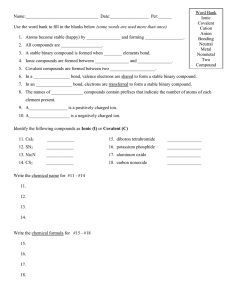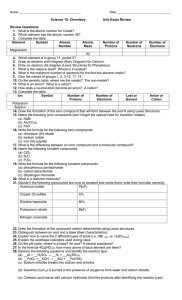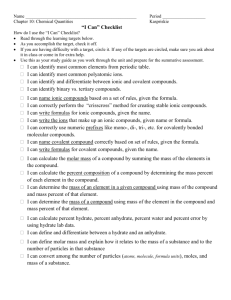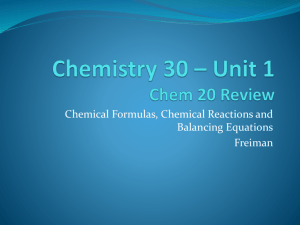Chemical Compounds Honors Chemistry
advertisement
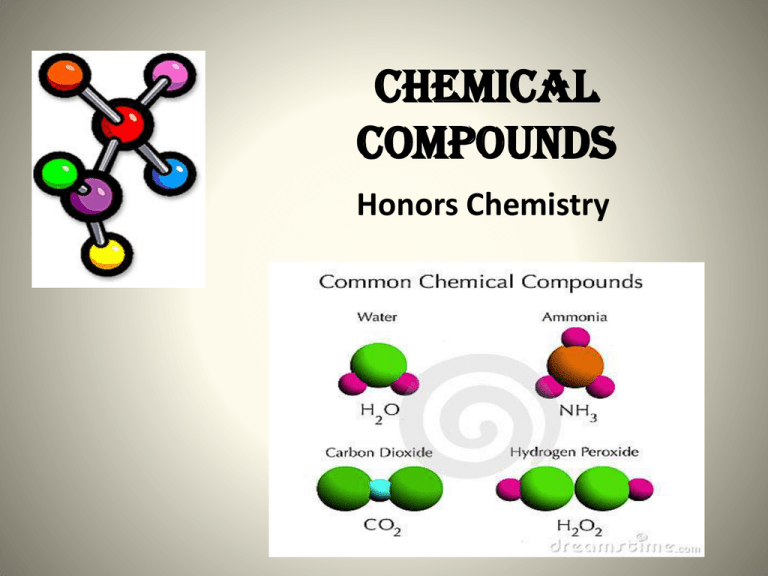
Chemical Compounds Honors Chemistry 3 Types of Formulas • Empirical: Smallest whole-number-ratio of atoms or ions in a compound – Ex. CH2 NH3 • Molecular: Tells you the actual number of atoms of an element in a compound – Ex. C2H4 N2H6 • Structural: Indicates how the atoms are bonded to each other How does the mole relate to compounds? REMEMBER Atoms are too small to count or mass individually. It is easier to count many or mass many. amu gram (atomic scale) (macroscopic scale) mole atoms, ions, molecules, or formula units Molar Mass = mass, in grams, per 1 mole of a substance units = grams/mole (g/mol) Example: the molar mass of H2O is 18.0 g/mol Molecular formulas and molar masses are used to determine Percent Composition 1. Definition: percentage, by mass, of each element in a compound % Composition = (part/whole) x 100 2. Problems a. Calculate the % composition of NaCl % Na: 39.3% Na % Cl: 60.7% Cl Percent Composition of Hydrate Definition: A hydrate is an ionic compound with water embedded in it. b. Calculate the % water in a hydrate, Mg3(PO4)2 . 6H2O. 370.9 g/mol Mg3(PO4)2 . 6H2O molar mass of hydrate = molar mass of anhydrate + x(molar mass of water) % water = 29.1% H2O How can you identify different types of compounds? • Type of Compound Identification • Ionic Begins with a metal • Covalent Begins with a nonmetal • Acid Begins with a hydrogen and is aqueous • Hydrate Ionic Compound and Water Ionic Compounds • Made from a positively and negatively charged ion • Overall charge of the compound is zero • Types of Ionic Compounds – Binary – Ternary Binary Compounds: Composed of two monatomic ions • Primary Rules for Charges: YOU MUST KNOW THESE RULES 1 or IA +1 2 or IIA +2 13 or IIIA +3 15 or VA -3 in binary compounds with metals, H, or NH4+ 16 or VIA -2 in binary compounds with metals, H, or NH4+ 17 or VIIA -1 in binary compounds with metals, H, or NH4+ Ionic Compounds – look at charges; roman numerals needed for elements with more than one charge (polyvalent) a. Binary Compounds – only monatomic ions in compound sodium chloride NaCl iron(III) sulfide Fe2S3 FeS iron(II) sulfide Ionic Compounds Binary Compounds HF(g) hydrogen fluoride AlCl3 aluminum chloride Cr2O3 chromium(III) oxide Ionic Compounds Ternary Compounds – contain 1/more polyatomic ions in compound sodium carbonate Na CO 2 3 chromium(III) oxalate Cr2(C2O4)3 ammonium sulfate (NH4)2SO4 Ionic Compounds • Ternary Co3(AsO4)2 CuSO3 cobalt(II) arsenate copper(II) sulfite Note for polyatomic ions: -ate vs. –ite per- and hypo- Ionic Compounds • magnesium hydroxide • calcium sulfate • ammonium phosphate Mg(OH)2 CaSO4 (NH4)3PO4 Anion Description Example per_____ ate 1 extra oxygen ClO4-1 perchlorate _______ate the most common form ClO3-1 chlorate _______ ite 1 less oxygen ClO2-1 chlorite hypo_____ ite 2 less oxygens ClO-1 hypochlorite Now try these… • sulfite SO3-2 • periodate IO4-1 • phosphite PO3-3 • bisulfite HSO3-1 Check for Understanding • magnesium hydride • calcium acetate • FeS2O3 • SnI4 MgH2 Ca(CH3COO)2 iron (II) thiosulfate tin (IV) odide Molecular Compounds – formed between 2 nonmetals *Use prefixes mono = 1 di = 2 tri = 3 tetra = 4 penta = 5 hexa = 6 hepta = 7 octa = 8 nona = 9 deca = 10 Binary Compounds: only 2 elements in the compound; use prefixes and –ide ending CCl4 carbon tetrachloride N2O5 dinitrogen pentoxide More Practice • dihydrogen monoxide • nitrogen tetrabromide • S2O6 H2O NBr4 disulfur hexoxide Hydrates – ionic compound with water bonded in its structure anhydrate . xH2O • anhydrate ionic compound • add prefix to indicate # of water molecules CuSO4 . 5H2O copper(II) sulfate pentahydrate Acids – compounds that produce hydrogen ions in water 1. Mineral Acids Binary Acids 1st word: prefix = hydro root formed from anion suffix –ide changed to -ic 2nd word: acid a. HCl(aq) HBr(aq) hydrochloric acid hydrobromic acid B. Oxyacids • 1st word: root from anion Suffix ate changed to ic Suffix ite changed to ous **Exceptions: if you have sulf or phos as roots, change the root to sulfur or phosphor • 2nd word: acid HNO3 HNO2 phosphorous acid Nitric acid Nitrous acid H3PO3 2. Organic Acids • 1st word: root formed from anion Suffix ate changed to ic • 2nd word: acid C6H5COOH(aq) or HC6H5COO(aq) acetic acid Benzoic acid HCH3COO or CH3COOH Common Acids to Know • • • • • • • hydrochloric acid HCl carbonic acid H2CO3 perchloric acid HClO4 sulfuric acid H2SO4 phosphoric acid H3PO4 nitric acid HNO3 CH3COOH = HC2H3O2 acetic acid Salts • Ionic compound composed of a cation (positive ion) and an anion (negative ion) from an acid • • • • NaCl CaSO4 NaHCO3 NaHSO3
